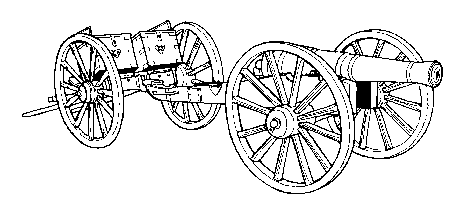|
First called the fore-carriage, the earliest description of a limber occurs - strangely enough - in an English paper dated 1497, while the oldest illustration fitting the description is a German etching dated 1518. It consists simply of two wheels, an axletree with a pintle for attachment of the trail, plus a draught connector to which one or two swingletrees might be attached. Evidently the draught system was not successful for it was soon superseded by shaft draught, ie two shafts between which a horse was harnessed, connected directly to the front of the limber. Additional horses were hooked in ahead of the shaft horse. However, the method was suitable only for lighter guns, eg 3- and 6-prs. In order to facilitate the use of horses in pairs for the heavier equipments Britain adopted a system in which the shafts were offset, ie the off shaft was connected to the axle at the off limber wheel, while the near shaft was connected to the centre of the limber. Whatever the system, shaft draught proved less than satisfactory because firstly the shaft horse had to have a different set of harness from the others. Secondly, because early limber wheels were smaller than the gun wheels, the angle formed by the shafts and the traces of the leading horses caused the shafts to be pulled downward, thus making life difficult for the shaft horse. The fitting of the limber wheels the same size as gun wheels eased the strain on the shaft horse to some extent but only partially solved the problem. Consequently, by about the middle of the 17th century nations on the Continent had adopted pole draught.  |
|
WL Ruffell Issue 78 June 1993 |
previous | index | next |
History Home Page | Old Comrades' Home Page
Send suggestions or comments to the Webmaster
Page last updated: January 2000